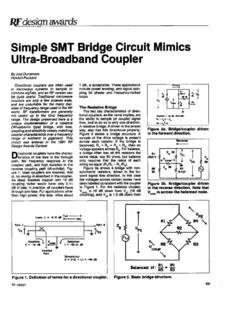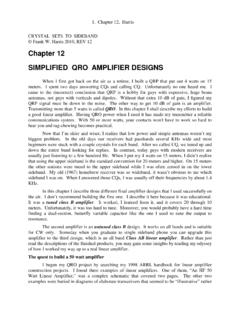Transcription of When is a Balun, not a balun, when it is an UNUN
1 The balun and The UNUN - page 1 when is a balun , not a balun , when it is an UNUN ! balun = "BALanced-to-UNbalanced" Unun = "UNbalanced-to-UNbalanced" Looking at the two diagrams above you will see the common terminal for the balun goes to the HOT terminal of the unbalanced side where as the common terminal in the UNUN goes to the COLD side of both the input and the output. when we say a balun or UNUN is a 4 to 1 device it will work just as well backwards. A 4 to1 balun can also match 50 Ohm to 12 Ohms, and a 9 to 1 can match 50 Ohm to 5 ohms. Working in the forward direction a 1 to 1 is 50 in 50 out. A '4 to 1' will convert the 50 ohms of your coax to 200 ohms ' ie 4 times' A '9 to 1' will convert the 50 ohms of your coax to 450 ohms ' ie 9 times ' And now for a few wise words from VK5 AJL, John Langsford, visit his web site for the whole story The balun and The UNUN - page 2 Voltage balun A voltage balun utilises some form of transformer action to transfer energy back and forth between a balanced and unbalanced transmission line.
2 A voltage balun involves the transformation of a voltage, often using a core type transformer (even if 1:1) but that definition need not be so restrictive and can include a half wave loop. This implies the transformation of impedance (even if the same). It also includes auto-transformers like the Guanella balun . Current balun A current balun allows working currents to pass but chokes common mode currents - nothing more. There is no transformer action. Because it is a current controlling device and not a transformer, there can be no such thing as a 4:1 current balun . Put another way, a current balun controls currents presenting a low impedance, through the device, to desired currents but a high impedance to unwanted ones. See the action described for a core type current balun below for a description of how such a device works. Simple 1:1 voltage balun A voltage transformer type balun uses magnetic transfer (transformer action) to produce a balanced signal at the output.
3 The 1:1 impedance transformation is achieved by making the impedance of each winding the same. If changing the number of turns on one (or more) winding changes the Simple 1:1 current balun A 1:1 current balun controls currents. There is NO transformer action. Equal and opposite (balanced) currents cancel each other out and present a low impedance. Common mode currents produce a mutually inductive magnetic field that presents a high impedance to these, unwanted, signals. If the number of turns on one winding The balun and The UNUN - page 3 voltage, it is a voltage balun . Working currents flow (indicated by the arrows in the above diagram) are induced through the core, in the same sense in the voltage balun but are in an opposite sense cancelling each other out (are not induced through the core) in a current balun . is made different to the other, the action will remain the same except that there will now be a small impedance associated with balanced currents but still a much higher impedance for to common mode currents.
4 If changing the number of turns on one (or more) winding changes the current, it is a current balun . Common Mode currents Coaxial cables with shields more than several skin depths thick always carry equal and opposite flowing currents on the inside of their shields and their centre conductors. Current direction and current ratio between the centre conductor and inside of the shield in a non-radiating coaxial line is no different than currents in each conductor of a perfectly balanced ladder line. In both unbalanced coaxial lines and balanced lines, the two conductors making up the line carry equal and opposite flowing currents. when currents flow without close-by opposing currents, we call the unopposed portion of current common mode current. Common mode currents promote or encourage external coupling and radiation. In a dipole antenna, or any antenna for that matter, common mode currents in the antenna element are responsible for radiation.
5 In the ham shack or along a feed-line, common mode current is responsible for unwanted noise ingress, RFI, RF burns, and a host of other maladies. Common mode currents, in effect, bring the radiating system into the feed-line or station equipment. Common-mode currents, or currents flowing in the same direction, cannot exist inside a coaxial cable at any frequency where the shield is several skin depths thick. Shield skin depth serves to isolate the inside of the shield from the outer wall of the shield. Common mode (same direction) currents can only flow on the outside of the coaxial cable shield. Differential mode currents, or normal transmission line currents, flow on the inner surface of the shield wall. Currents entering and leaving the shield and centre conductor at each end of a coaxial line must be equal and opposite or the cable will radiate. If a coaxial line is not radiating, currents in the shield and centre conductor are exactly balanced and opposite flowing.
6 Both types of transmission lines, balanced and unbalanced, will have equal and opposite currents entering and leaving each conductor when they have minimal radiation. FERRITE vs POWDERED IRON The balun and The UNUN - page 4 Both ferrite and powdered iron cores are ceramic materials. They consist of small particles of either iron (for powdered iron obviously) or mixtures of iron oxides mixed with binding substances and are fired in a kiln like pottery. Both are more efficient than solid iron. There are advantages and disadvantages to using both. Ferrite saturates (fills up with a magnetic field) at a lower level than powdered iron. After any core saturates, it behaves like just a piece of wire and not like a coil anymore. You must also remember that the relationship between magnetic field strength and ampere turns is not linear so, the closer you are working to the saturation point of any core, the more harmonics (mostly odd harmonics) you produce.
7 Suppose you have a powdered iron core and a ferrite core of the same size. Suppose the powdered iron core saturates at 12 watts and the ferrite core at 10 watts. If you put 5 watts through them, the ferrite, being more efficient, will transfer more power. If, on the other hand, you put 9 watts through it, although the powdered iron is less efficient, less power is lost in the harmonics. The power transfer at the desired frequency will now be the about the same for both and you won't be disturbing the neighbours TV or upsetting the ACMA anymore. WINDING DETAILS The number of turns will depend on the core material. Since there are so many types, exact figures can't be quoted here. For an HF transformer and a powdered iron core, about nine or ten turns per winding is a good place to start. Since a current balun is a type of common mode choke, the more turns the better. There are several ways of testing it but none of them really easy.
8 If 10 turns works OK, leave it. If you really must be sure, one way to test it is to put power through it at increasing levels and run it into a dummy load. Wind a 1:1 balun with extra turns using the desired material connecting the primary to an RF source and ground and the secondary to a dummy load (50 ). You will need a BIG dummy load. Antenna s, SWR, Antenna Tuners and balun and UNUN Many modern HF transceivers come fully equipped with built in tuners. While these tuners are great for changing bands, the manufacturers left out a very important accessory; the 4 to 1 balun . Without a balun the transceiver can only feed an antenna which uses coaxial cable. While this may be satisfactory for some operators, this is a real problem for those of us who prefer the super low loss ladder line or wish to use simple loop or long wire antenna. The balun and The UNUN - page 5 The only other alternative is to buy an external tuner with a built-in balun which is really absurd after spending the additional money to have one built into the radio.
9 Fortunately a balun or UNUN can be easily home brewed On the other hand, let us assume for now the idea of using a balun /UNUN on a long-wire antenna is simply to bring the SWR within capabilities of some Automatic Antenna Tuning Units, especially the ones built into HF rigs. For example, the Kenwood TS-570 "Built-in AATU" is listed as only being capable of handling a SWR mismatch of 3to1, whereas a typical external AATU is listed as being happy to address at least 10 to 1. In a typical long wire antenna example, the 4:1 balun on 20m would serve to (maybe) bring that impedance down from 600 ohms (which the above Kenwood Tuner example would not like) to 150 Ohms which, in theory, the Tuner would handle. And now for some balun designs you can build The VK5 SRP 4 to 1 balun (this balun is usually used as 1 to 4) In an article later in this paper, Lars mentions using Teflon covered wire but this is not easy to obtain here DownUnder and if you do find it you will have to buy a very large quantity.
10 Regular Enamelled copper wire available from Jaycar and Altronics will work fine and I have found 7 hook-up wire or 14 twin (medium duty speaker wire) works fine. Much easier to get a nice even winding using these materials. Each winding should be 10 to 14 turns. The more turns the better the low frequency performance. The winding must also be wound tightly onto the core with no turns overlapping other turns. With the cores we are using you will require about 800 mm of wire for each winding. when you wind the core space the wire evenly round the outside of the core. The cores that are readily available here are the FT140-61 from Mini-Kits. This core will be adequate for up to 200 Watt and if you wish to have a higher power capability you can use the FT240-61, this should be good to 400 Watt or more. The balun and The UNUN - page 6 The A1 and B1in these drawing are used to indicates the start of that winding. An alternative method of labelling the start of a winding is to use a dot on the start of each wining.







